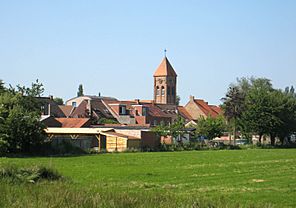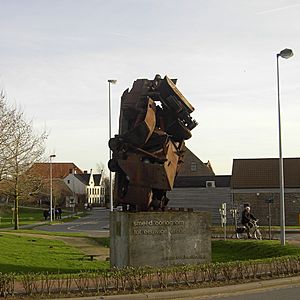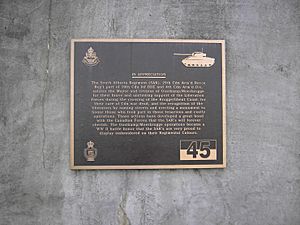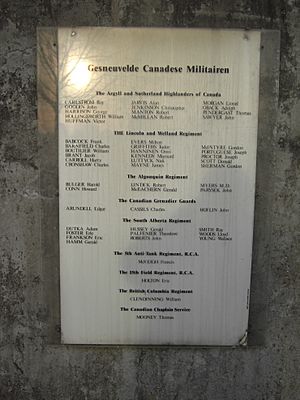Battle of Moerbrugge facts for kids
Quick facts for kids Battle of Moerbrugge |
|||||||
|---|---|---|---|---|---|---|---|
| Part of the Liberation of Belgium | |||||||
 Modern day Moerbrugge |
|||||||
|
|||||||
| Belligerents | |||||||
| Commanders and leaders | |||||||
| J. David Stewart | Unknown | ||||||
| Strength | |||||||
| Elements of 64th Infantry Division | |||||||
| Casualties and losses | |||||||
| 250 killed wounded or captured | 700 killed, wounded or captured 20 AA guns captured 8 mortars captured |
||||||
The Battle of Moerbrugge was a tough three-day fight during World War II. It took place in September 1944 as Allied forces were freeing Belgium from German control. Canadian soldiers faced strong German resistance while trying to cross a wide canal. This battle showed the great bravery of the Canadian troops.
In early September 1944, the 10th Canadian Infantry Brigade was given a big job. They had to cross the Ghent Canal near the small village of Oostkamp, south of Bruges. Right across the canal was another village called Moerbrugge. The canal was about 20 metres (65 feet) wide and very deep.
The Canadian commanders thought the crossing would be easy. So, only one group of soldiers, the Argyll and Sutherland Highlanders of Canada (the Argylls), was chosen to cross.
Two groups of artillery guns were ready to help. But the Allied armies had moved very fast. Their supply lines were hundreds of miles long. This meant there wasn't much ammunition for the big guns. So, the artillery would only fire if absolutely needed.
Tanks from The South Alberta Regiment (SARs) were placed on the friendly side of the canal. They would protect the sides of the crossing area with their fire. Vickers machine guns from The New Brunswick Rangers also helped. Mortars (small cannons that fire shells high into the air) from the Argylls and Rangers were also ready. But they, too, had low ammunition.
To trick the Germans, one company of Argylls, their scout team, and a group of SARs tanks moved north along the canal. Their job was to make the Germans think the main attack would happen there.
At this time, the Argylls' main commander, Lieutenant Colonel Dave Stewart, was away. Major B. Stockloser was in charge. He ordered three companies ("B", "C", and "D") to cross the canal. But he hadn't arranged for special boats. He said the crossing would be "an opportunity."
Crossing the Canal
At 3:30 PM on September 8, 1944, the three companies moved to Oostkamp. Luckily, the "opportunity" Major Stockloser talked about appeared. Major Mackenzie, who led "D" Company, found two civilian boats. These boats would eventually carry all three companies across the canal.
Some boats sank during the crossing. Soldiers carrying heavy gear drowned in the deep water. At 5:30 PM, "D" Company began to cross. Soon, the Germans started firing back with powerful 88mm guns and mortars. Soldiers were hurt even before they reached the other side. In just two hours, "C" Company's strength dropped from 63 men to only 46. By midnight, all three companies had crossed. They held a small area on the far side of the canal.
Major Mackenzie was wounded. "D" Company was pushed back towards the canal by German counter-attacks. "C" Company was cut off from "B" and "D" Companies because German soldiers slipped in between them. By the end of the day, 5 Argylls were killed and 26 were wounded.
Holding the Line
On September 9, 1944, The Lincoln and Welland Regiment crossed the canal. They took up a position on the right side of the Argylls. The situation remained very serious all day. The Germans launched several strong counter-attacks against the small area the Canadians held.
Corporal James Alexander of "A" Company showed great bravery that day. He was awarded the Military Medal. He was wounded around 10:00 AM. After his wounds were treated, he asked to go back to his company. An enemy counter-attack started quickly. Corporal Alexander was wounded again by a shell that hit a wall near his head. He ignored both wounds. He gathered his team, grabbed a Bren gun, and stood fully exposed to enemy fire. He did this to cover his men who had become separated.
"C" Company was in a very difficult spot. They were cut off from the other companies. Their radios also stopped working, so they couldn't talk to anyone for help. But the company held on. They fought off all German attacks. Company Sergeant Major George Mitchell deserves much praise for keeping the defense together. He personally led a group that brought much-needed supplies and ammunition. After the battle, he received the Distinguished Conduct Medal.
Lance Corporal Lorne A. Webb and Private Arthur Bridge held their position in an upstairs window. They fired their Bren gun despite German machine gun and 20mm cannon fire aimed at them. Some shots went through the window but missed them. When ammunition ran low, the riflemen loaded their remaining bullets into Bren magazines. They kept feeding them to the Bren gunners. At one point, Webb hurt 15 to 20 attacking Germans in just a few minutes. Three heavy German counter-attacks on "C" Company were beaten back. The Germans suffered very heavy losses. However, one Canadian platoon was overwhelmed by the sheer number of German soldiers, and its commander was killed.
The Germans kept shelling and mortaring the crossing site. This made it impossible for engineers to build a Bailey bridge (a type of portable bridge). So, supplies and ammunition had to be carried across the canal in boats. Slowly, more artillery ammunition reached the Canadian guns, and their supporting fire increased. The SARs and New Brunswick Rangers continued to protect the sides of the attacking force.
At 2:00 PM, "A" Company and the Scout Platoon were called back from their trick mission. They moved to a supporting position on the friendly side of the canal. Commanders worried that the small area held by the Canadians might collapse. They feared the six Canadian companies in Moerbrugge might have to leave.
At 3:00 PM, Lieutenant Colonel Stewart returned to his unit. The brigade commander put him in charge of the crossing. He immediately started to reorganize the positions on the other side of the canal.
At 7:00 PM, the Germans fired a huge amount of mortar shells on both sides of the crossing. This was meant to prepare for their final counter-attack. But their attack was stopped and pushed back. Because of the heavy fire, the engineers had to stop building the bridge again. However, by midnight, Canadian artillery fire finally stopped the German shelling of the bridge site. The Argylls lost 7 killed, 22 wounded, and 12 captured during the day.
By the morning of September 10, 1944, the engineers finally finished the bridge. SAR tanks moved across it and connected with the cut-off "C" Company. About 150 German prisoners were sent back over the new bridge.
After the Battle
It's estimated that 700 Germans were killed, wounded, or captured during the Battle of Moerbrugge. Twenty of their 20mm FLAK (anti-aircraft) cannons were captured, along with six 81mm mortars. German shelling and mortaring continued off and on all day. But the Canadians now firmly controlled the crossing site. One Argyll soldier died and two were wounded on September 10.




